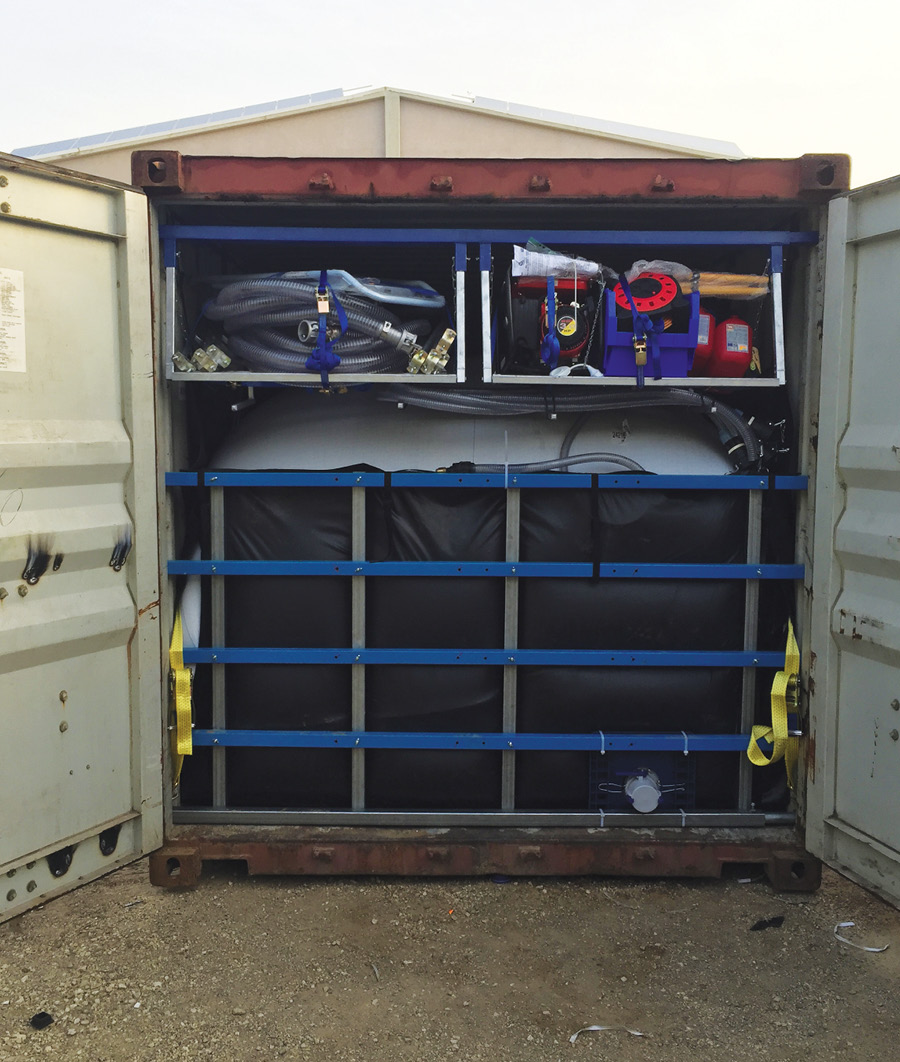
by ALEX HAREL
When fighting fires in areas where a water supply or hydrants are not available (wildfires, remote locations, rural areas, and so on), one of the major problems responders face is getting a water supply to the fire engines. A typical fire engine contains 750 to 1,000 gallons (3,000 to 4,000 liters) of water. When hydrants are not available to connect to an online water supply, the engines need to leave the “line of fire,” thus reducing the “time on fire” (TOF), and spend more time traveling back and forth for water supply.

(1) Photo courtesy of EZPack Water Ltd.
The drought in California has resulted in engines needing to travel longer distances to water sources. A partial solution to this problem would be using tankers that are part of the firefighting units and stations. However, such tankers are expensive, and only a limited number of them are available; the availability of tankers that you can rent on demand is also limited.
Israel has introduced a new approach to this problem, which is the result of a joint effort between the Israel Fire Authorities and two Israeli companies—EZPack Water Ltd. and Fridenson Water Solutions Ltd. The EZPack™ water storage and distribution system is a comprehensive water solution for such emergency and disaster situations. The system is easy to operate, is compact to store, and can be assembled quickly. This new approach is based on the “Water-Push” concept, which brings the water for the fire engines as close as possible to the firefighting line so the engines will spend minimum time on water refilling, significantly increasing the TOF.
The following elements have been developed to support the Water-Push concept:
- Solutions enabling the use of standard flatbed engines and trailers as “on-demand” water tankers.
- ) The HipoKit™. This special conversion kit converts any flatbed truck or trailer into a tanker. Using the kit, a standard truck/trailer can carry about 3,500 gallons (14,000 liters) of water, and an 18-wheeler can carry about 7,000 gallons (28,000 liters). Installing the kit takes two to three hours and offers an immediate supply of water. It requires no maintenance, features a short setup time (up to one hour for a two-person team), and requires no tools for installation.
- ) The FlexCon™ (photo 1). This special conversion kit converts any standard 20-foot container into a 6,000-gallon (24,000-liter) tanker within 30 minutes.
- Based on the FlexCon™, you can build a local temporary water storage unit with 20-foot containers that hold 6,000 gallons (24,000 liters) of water each or with 40-foot containers that hold 12,000 gallons (48,000 liters), with each container in proximity to the firefighting line. All containers are connected to operate as one large water storage. The volume of the water storage is defined according to the local requirements. Typical water storage sizes are 50,000 to 200,000 gallons.
The concept of pushing the water to the fire line has the following advantages:
- The fire engines stay close to the fire line.
- The water is pushed forward.
- The HipoKit™ and FlexCon™ are called into action and are modified within hours (the first one is ready after one hour).
- The Water-Push platform shuttles between the fire line and the nearest available water source for a constant water supply.
- At the end of the event, the equipment is stored in a relatively small and compact storage area, ready for the next event.
Trucks and containers are available from various sources and can be rented for a specific period. You can also arrange long-term on-call agreements, provided the equipment is ready 24/7 as needed. The fire department does not need to invest a significant amount of money in tankers, which cost hundreds of thousands of dollars. Instead, the only capital investment required is in the flatbed trucks and the conversion kits.
The Water-Push concept for firefighting was developed in Israel and presents a novel, practical, and cost-effective solution for supplying water to fire engines during wildfires and in remote locations (or any location where water supply is limited). It is a scalable solution that you can build according to the requirements for your fire department. The equipment used (flatbed trucks and containers) is widely available and, therefore, allows a fleet to respond to any scenario and to be available at the fire scene in a relatively short time.
ALEX HAREL is the CEO of EZPack Water Ltd.

